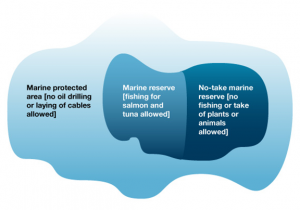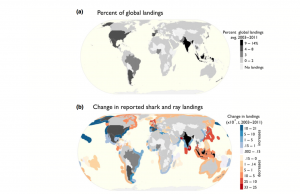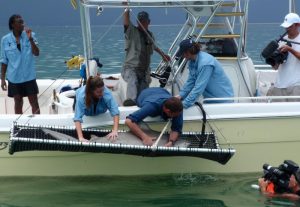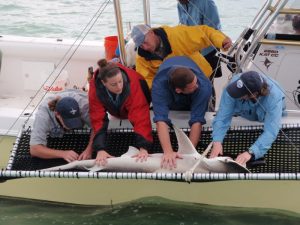By Christina Marmet,
Marine conservation student
Sharks have been around for 450 million years, and have survived every extinction episode that our Earth has known since then (Litman 1996). However, human beings may be the biggest threat they have ever faced.
Today, there are about 500 species of sharks in the ocean, with more being discovered regularly. However, according to the IUCN Red List, more than one-third of all oceanic shark species are at risk of extinction. They are endangered mostly because of overfishing and the increased loss and degradation of coastal habitats (Stevens et al. 2000, Ferretti et al. 2010).
One of many possible solutions to help protect sharks is to create marine protected areas (MPAs), especially in coastal areas where sharks are most vulnerable to human impacts. However, in most cases, lack of knowledge regarding the movement patterns of sharks hinders the establishment of specific shark protected areas.
The National Oceanic and Atmospheric Administration MPA Center defines marine protected areas as “any area of the marine environment that has been reserved by federal, state, territorial, tribal, or local laws or regulations to provide lasting protection for part or all of the natural and cultural resources therein” (NOAA MPA Center www.mpa.gov accessed Nov. 1, 2012).

Hypothetical example of a marine protected area, a marine reserve, and a no-take marine reserve. Source: Pacific Fishery Management Council (www.pcouncil.org)
MPAs are put in place mostly for the protection and conservation of rare and endangered marine species and habitats, as well as to maintain the biodiversity of a specific area (Agardy 1997). MPAs can also help preserve the socio-economic value of a marine area for human use through fisheries or recreation. They are thought to be most effective at protecting sedentary species – animals who have very little movement or are attached to something – as most MPAs are small in size, and the benefits from the protection diminishes once individuals move outside the boundaries (Bonfil 1999).
Many MPAs have been put in place without prior knowledge of how they will function due to the urgent need for protection of marine environments (Roberts, 2000). In Knip et al. (2012), the aim of the study was to evaluate the possible degree to which existing MPAs may shelter shark populations by tracking the movements of two tropical coastal species within two MPA regions in the Great Barrier Reef Marine Park, Australia. Their hypothesis was that coastal sharks received conservation benefits from the MPAs by staying inside the boundaries (Knip et al. 2012).
The research was conducted from 2009 to 2010 in Cleveland Bay, within which there are two Conservation Park (CP) zones with strict fishing restrictions (Knip et al. 2012). During the course of the study, 37 pigeye sharks (Carcharhinus amboinensis) and 20 spottail sharks (Carcharhinus sorrah) were fitted with acoustic transmitters. Receivers were deployed throughout the two CP zones to monitor shark movement and residency inside the MPA (Knip et al 2012).
Acoustic transmitters allow scientists to know the location of tagged animals and time at which they pass within the range of the receivers (Welch 2005). Downloading of receiver data occurred every 6-8 weeks (Knip et al. 2012). The acoustic receivers were placed only inside the CP zones. Consequently, the interval between all detections was calculated for each individual shark to determine the length of time outside the protected area. The scientists concluded that the longer the interval between detections, the more likely the shark had exited the MPA (Knip et al. 2012).
The acoustic tagging led to the findings that pigeye sharks spent a mean of 23% of their time inside the MPA, while spottail spent a mean of 32% (Knip et. Al 2012). They also discovered seasonal variations: pigeye sharks spent twice as long in the MPAs in summer than winter, and the opposite pattern was apparent among spottail sharks (Knip et al. 2012). All individuals made excursions outside of MPAs, but the number and duration of the excursions varied among individuals of both species (Knip et al. 2012).
The authors recognized that these results lead us to believe that these two species of sharks are beneficiaries of the marine protected areas. It undeniably shows a certain degree of protection for the sharks, as they were found spending a noteworthy amount of time in the MPAs. However, the percentages also show that the sharks are out of the reserve 70 to 80% of the time, suggesting that MPAs in this region provide only limited protections for these two species, and potentially for all mobile species.
Indeed, the authors suggested that the degree of MPA effectiveness would in part depend on the seasonality of the nearby fishery industry, with respect to the seasonality and timing of excursions of sharks from MPAs (Knip et al. 2012). It would have been interesting to look at precise bycatch data, such as how many fishermen incidentally catch and release sharks, and where and when exactly they catch them. The authors mention that the location where the sharks exit the MPAs is of critical importance for conservation. Most fishing effort in this region occurs in the intertidal zone, which is where the pigeye sharks prefer to cross out of the CP zones (Knip et al. 2012). The effects of fishing pressure were obvious: fishers in this region removed 21% of the pigeye shark population, while there was no capture of spottail sharks (Knip et al. 2012), thus suggesting the need for fisheries regulations in and around the MPAs. Unfortunately, there was no discussion of fishermen sample size, and it is thus hard to determine the significance of this catch, which may represent only a fraction of total fishing threat.
This paper demonstrates the importance of knowing the movement patterns of sharks and other mobile species in order to create better conservation areas. Undeniably, it would be worth spending more time looking at the reasons for the crossing patterns in and out of the MPAs for these two species of sharks. Besides, if the area adjacent to an MPA boundary is heavily fished, the risk of capture for an individual will remain high even if it spends most of its time inside the MPA (Knip et al. 2012).
This study was among the first to evaluate the efficacy of MPAs for shark conservation (Knip et al. 2012). Consequently, it proved that not only the creation of MPAs could be an important contributor to shark conservation, but also that better knowledge of shark behavior would most likely encourage the development of more specific and effective fisheries-management plans. The authors suggest an ‘onion-ring’ type approach to MPA design, where core areas would be buffered by outer zones that exclude potentially high impact fisheries (Knip et al. 2012). It can be concluded that the effectiveness of MPAs for sharks is dramatically decreased by certain fishing activities nearby, and that there is a need for better MPA regulations in and around protected areas.
The authors came to the conclusion that this study demonstrated that individual MPAs may generate benefits for multiple shark species, and thus did not need to follow a species specific initiative (Knip et al. 2012). Although this study demonstrates that MPAs are a good first step to protecting even highly mobile species, it is crucial to remember the great diversity of shark species. These findings can really only be generalized to other shark species with similar life history and behavioral characteristics. Consequently, more research into the potential for MPAs to contribute to shark conservation is needed in different ecosystems worldwide.
REFERENCES
Agardy, T.S. (1997) Marine Protected Areas and Ocean Conservation. Academic Press, San Diego.
Ferretti, F., Worm, B., Britten, G.L., Heithaus M.R. & Lotze H.K. (2010) Patterns and ecosystem consequences of shark declines in the ocean. Ecology Letters, 13, 1055-1071
IUCN Red List. (2012) Accessed 1 Nov. http://www.iucnredlist.org
Litman, G.W. (1996) Sharks and the origins of vertebrate immunity. Scientific American, 275, 67.
National Oceanic and Atmospheric Administration (NOAA) – National Marine Protected Area (MPA) Center. Accessed 1 Nov. 2012 http://www.mpa.gov/aboutmpas/definition/
Pacific Fishery Management Council. (2012) Habitat and Communities: Marine Reserves and Marine Protected Areas. Accessed 1 Nov. http://www.pcouncil.org/habitat-and-communities/marine-protected-areas/
Roberts, C.M. (2000) Selecting Marine Reserve Locations: optimality versus opportunism. Bull. Mar. Sci. 66, 581-592.
Stevens, J.D., Bonfil, R., Dulvy, N.K., Walker, P.A. (2000) The effects of fishing on sharks, rays, and chimaeras (chondrichthyans), and the implications for marine ecosystems. ICES J, Mar. Sci. 57, 476-494.
Welch, D. (2005) Tiny Acoustic Transmitters Help Map Salmon Tracks in the Ocean. Accessed 1 Nov. 2012 http://www.aip.org/149th/tsang.html
Wildlife Extra News. 2008 http://www.wildlifeextra.com/go/news/shark-tagging546.html#cr












